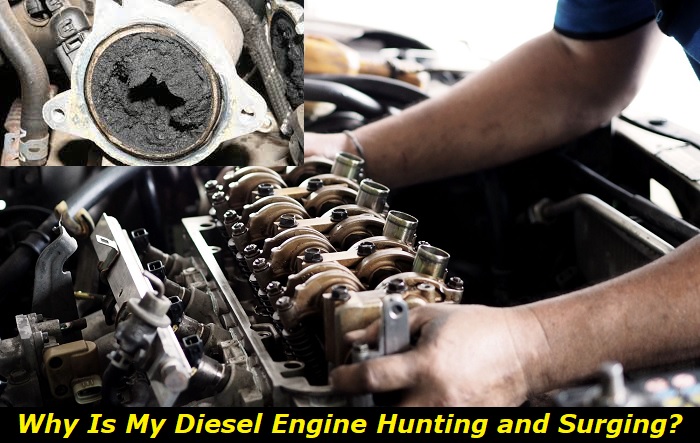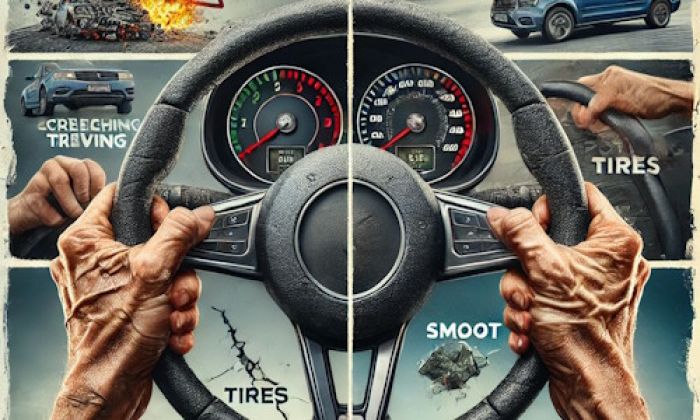Clogged fuel filters, vacuum leaks, faulty fuel pressure regulators, and catalytic converters mainly cause diesel engine hunting and surging. Cleaning the blocked fuel filters, sealing vacuum leaks, and replacing faulty components in the engine are required to fix the problem.
Diesel engine problems highlights
- Level of importance:Medium
- Commonreasons:Age and mileage, aggressive driving, poor maintenance
- DIY inspection:In most cases, impossible
- DIY repair:Impossible
- Price for repair:$650 - $1,500
- Can you drive?Depends on the issue
- Ways to fix:Replace the worn-out parts, professionalrepair is usually possible only

Causes of a diesel engine's hunting and surging
The first step in solving a diesel engine's hunting and surging problem is by conducting a diagnosis to determine what is ailing your engine. You may need professional help to do that, but I hope that won't be necessary after reading through the following causes.
1) Vacuum leaks
Your diesel engine relies on fuel and air for combustion, which aids in generating power that enables the engine to run. Excess air enters the engine when a vacuum leaks, altering the air-fuel ratio balance. This imbalance leads to an engine malfunction, and one of the symptoms is an engine surge.
2) Clogged fuel filter
Fuel injectors in the diesel engine have fine-meshed filters. These filters are prone to blockage even by small particles. When they are clogged, fuel pressure reduces, making the Electronic Control Module (ECM) widen the injector's entrance to regulate the amount of fuel flow.
As the electronic control module opens the fuel injectors, fuel pressure spikes, injecting more fuel into your vehicle's engine to try and maintain the fuel-air ratio. The extra fuel injected will cause the engine to experience hunting and surging as you drive.
3) Stuck Exhaust Gas Recirculation (EGR) valve
The EGR valve recirculates the combustion chamber's exhaust. This recirculation enables the exhaust combust again instead of directing it into the emission system, which decreases emissions.
During the engine's cycles, the EGR valve opens and closes systematically. When the EGR valve is stuck at the open position, exhaust gas returns to the chamber, leaving excess carbon dioxide.
As there is not enough oxygen, the Electronic Control Module will overcompensate by allowing more air to reach the chamber via the intake manifold. This occurrence will make your engine "run lean," thus causing it to experience surges.
4) Bad diesel fuel
When the fuel comes into contact with the air in the cylinder, the fuel is oxidized. The process entails a chemical reaction between the fuel and oxygen to form carbon dioxide, water, and pollutants like nitric oxides and carbon molecules. For this reaction to be helpful in the smooth running of the engine, it must follow the recommended air-fuel ratio.
When the engine receives bad diesel fuel, the Electronic Control Module (ECM) treats it as excess air in the fuel. To fix the problem, the ECM injects more fuel into the engine to balance the fuel-air ratio for combustion. The excess bad fuel causes a decrease in the air temperature in the combustion chambers; thus, the engine will have a "lean burn."
When the "lean burn" occurs, the ECM will try to fix the situation again by reducing the pace of fuel injection, and the cycle continues. Engine surging and hunting will occur at this point as the engine burns lean, and it takes too long to overcompensate.
5) Faulty catalytic converters
The diesel engine has catalytic converters which help in replacing toxic fumes. It converts harmful fumes like hydrocarbons, nitric oxide, and carbon monoxide into less toxic fumes like carbon dioxide, water vapor, and nitrogen.
A broken or degraded catalytic converter leads to loss of power by the engine. The engine will, in turn, start delaying when you try to accelerate.
It is good to keep checking the catalytic converters' condition to prevent future hunting and surging of your engine. You don't need to be overwhelmed. It is a DIY task. Use a backpressure gauge, an infrared thermometer, or a vacuum gauge to check the condition.
6) Faulty fuel pressure regulator
The regulator closes and opens based on the vacuum pressure to control fuel pressure in the injectors. If the faulty regulator operates at low pressure, the fuel system experiences erroneous fuel volume and pressure. The reduced fuel pressure will cause the engine to run lean, which causes deviations that will result in engine hunting and surging.
7) Overheated engine
When running on a hot engine, the head gaskets may blow, making the coolant seep out, thus pulling in air to the engine. The excess air creates an imbalance in the fuel-air ratio. As the electronic control module tries to fix the problem by compensating with less fuel injection, you will experience engine hunting and surging.
8) Faulty Electronic Control Module (ECM)
The ECM manages different functions of different vehicle parts, ensuring the proper running of the engine. The ECM compensates if there is a defect in any of these parts.
If the ECM is faulty, the optimal engine operation is curtailed. For instance, it can inject more fuel into the chamber, causing engine surges.
How to fix diesel engine hunting and surging
Fixing some of the engine's components, such as the catalytic converters, is technical and requires a professional. However, other fixes are DIY tasks, as shown below:
1) Replace the Exhaust Gas Recirculation (EGR) valve
The first step when replacing a faulty EGR valve is disconnecting the hose, the electrical connector, and the sensor. Use the following procedure to disconnect and install a new EGR valve:
- Ensure the engine is cool and detach the negative battery terminal.
- Remove the engine cover and disconnect the vacuum hose
- Use a wrench and socket to remove the valve's mounting bolts
- You can now remove the valve gasket and the EGR valve from their mounting
- Place the new EGR valve against the pipe
- Position the new gasket and tighten the mounting bolts
- You can now re-attach the vacuum hoses and plug in the electrical connector and the negative terminal of the battery
- Start your engine to see whether the EGR valve is functional and that there are no leaks
2) Clean/replace clogged fuel filters
To clean a blocked fuel filter, locate the pump fuse before removing the filter. The second step is to disconnect the negative battery terminal. Third, remove the bolts mounting the filter in position and check out for any remaining fuel in the filter to bleed it dry.
To remove debris from the filter, knock it gently against the sides of a container or wall, then flush through it with a fuel filter cleaner-Air-dry the filter for about an hour before reassembling it and mounting it back.
You may also replace the filters if they are worn out. A car repair shop will do that for you within a few hours.
3) Replace faulty fuel pressure regulator.
Usually, this is not a DIY job, but if you think you are up to the task, here is the procedure:
- To gain access to the regulator, unmount the air cleaner from the throttle body injection
- Disengage the fuel injector's electrical connection
- Unscrew the fuel injector retainer and move it to the side
- Remove the pressure cover and take note of the diaphragm cup, outlet tube, diaphragm spring, and the regulator's cover.
- Replace the old components with new ones one after the other and tighten the bolts.
- Connect the negative battery cable and turn the engine on to check for functionality and leaks.
4) Replace bad fuel
If you diagnose that the hunting and surging of your diesel engine emanate from contaminated fuel, remove the diesel tank and siphon out the fuel using a garden hose. Clean the diesel tank and refill it with clean diesel fuel.
5) Repair the electronic control module
Usually, this is not a DIY task. Get a qualified technician at the repair shop to test whether the ECM is getting enough power or if the fuel pumps, injectors, and starters are receiving the signals to act appropriately.
6) Flush the vehicle's cooling system
This falls under the category of a DIY task. Flush the cooling system with water, ignite the engine, let it cool down, drain the radiator, and refill it with water.
Repeat the process until your engine cools when you no longer experience hunting and surging.
Is it safe to drive a diesel engine with hunting and surging problems?
Typically, your vehicle can operate when it is hunting and surging. However, it will not perform optimally, and you can expect the problem to exacerbate with time. When you drive it for an extended period, it will cause damage to engine components such as the catalytic converters.
What is the cost of repairing a diesel engine that is hunting and surging?
The cost of the repair will depend on the diagnosis of the problem. Here are some average prices for fixing hunting and surging problems based on the cause:
- Replacing a fuel filter costs $70 to $160, including labor and parts. Your pay depends on your state and the repair shop you choose to take your vehicle.
- Replacing the Exhaust Gas Recirculation (EGR) valve will cost you about $279. However, the exact cost will depend on the type of your vehicle.
- Replacing a Fuel Pressure Regulator costs between $263 and $319, including labor and parts.
Bottom line
Diesel engine hunting and surging can indicate faulty engine or electronic control module components. Replacement of these components is preferable. However, don't rush to replace the components without a proper diagnosis by yourself or a professional mechanic.
About the authors
The CarAraC research team is composed of seasoned auto mechanics and automotive industry professionals, including individuals with advanced degrees and certifications in their field. Our team members boast prestigious credentials, reflecting their extensive knowledge and skills. These qualifications include: IMI: Institute of the Motor Industry, ASE-Certified Master Automobile Technicians; Coventry University, Graduate of MA in Automotive Journalism; Politecnico di Torino, Italy, MS Automotive Engineering; Ss. Cyril and Methodius University in Skopje, Mechanical University in Skopje; TOC Automotive College; DHA Suffa University, Department of Mechanical Engineering






Add comment